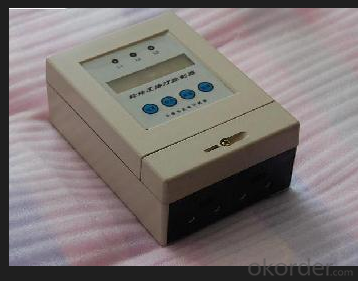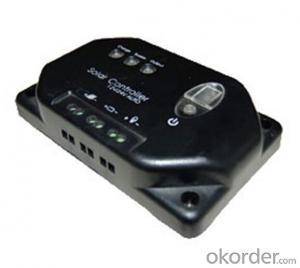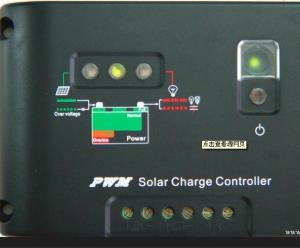PV Street Light Controller from China CNBM
- Loading Port:
- China Main Port
- Payment Terms:
- TT or LC
- Min Order Qty:
- -
- Supply Capability:
- -
OKorder Service Pledge
OKorder Financial Service
You Might Also Like
Description
CNBMSOLAR is a world-leading and Vertical integrated manufacturer of high-performance with Silicon,
Wafer, Cells, Modules, which convert sunlight into electricity for residential, commercial, and utility-scale
power generation.
The capacity of CNBMSOLAR is reach to 1GW, and make sure each year our shipment capacity is more
Than 700-800MWs, at the same time, we have set up the largest solar power station with our partner
in Ukraine.
CNBM is a Quality + Service oriented company with“Excellence at Each Step” approach, composed of
the finest components from TUV and IEC-certified partners around the world, CNBM modules consistently
undergo a variety of trials at the company’s Test & Development Centre, ensuring peak performance
capabilities. The company is committed to develop and provide the world with clean and renewable energy
to ease the energy shortages as well as human kind’s impact on the environment.
Data:
Model | GSR-1010CL-TAW | GSR-5010CP-TAW | |
Rated Capacity(A) | 10 | 10 | |
Rated Voltage(VDC) | 24 | 24 | |
Max.load current(A) | 10 | 10 | |
Max.charging current(A) | 10 | 50 | |
Charge Loops | 1 | 1 | |
Load Loops | 1 | 2 | |
Max. Open Circuit Voltage(VDC) | 50 | 50 | |
Overcharge protection | 28.4 | 28.4 | |
Overdischarge protection | Switch-Off | 21.6 | 21.6 |
Resumption | 26.4 | 26.4 | |
Current Without Load(mA) | 20 | 20 | |
Display | LED | indicator light | |
operating Model | 1.Light control time interval setting | 1.Light control time intervals setting Note:Already set before sent to customers | |
Temperature compensation | No | optional | |
Lightning protection devices(standard) | Varistors Lightning Protection | Varistors Lightning Protection | |
Protection | Overcharge, Overdischarge,overload, short circuit, reverse polarity, lightning arrestor | ||
Protection class | IP20 | ||
Voltage Descent | Between Solar battery and lead-acid battery | 0.7 | 0.7 |
Between lead-acid battery and load | 0.03 | 0.03 | |
Noisy(dB、1m) | ≤50 | ≤50 | |
Operating temperature(℃) | -20~+50 | -20~+50 | |
Storage temperature(℃) | -25~+55 | -25~+55 | |
Operating humidity | 0~95%(non-condensing) | 0~95%(non-condensing) | |
Operating Altitude(m) | ≤5000 | ≤5000 | |
Reference diamension(DxWxH)mm | 80×130×28 | 96×130×50 | |
Reference weight(Kg) | 0.5 | 3.0 | |

FAQ:Pls introduce more about CNBM
CNBM Group is short for China National Building Materials Group Corporation, which is established in 1984 with approval from the State Council
CNBM Group is the largest comprehensive building materials industry group in China
The Group has a total asset of over RMB 360 billion, more than 180,000 employees and 17 subsidiaries
- Q:What is the maximum voltage drop allowed between the solar panels and the solar controller?
- The maximum voltage drop allowed between the solar panels and the solar controller will depend on the specific system requirements and components being used. It is recommended to consult the manufacturer's specifications or guidelines for the solar panels and solar controller to determine the acceptable voltage drop threshold.
- Q:Can a solar controller be used with solar panel tilt and azimuth adjustment systems?
- Solar panel tilt and azimuth adjustment systems can be used in conjunction with a solar controller. The primary purpose of a solar controller is to regulate battery charging connected to solar panels. It monitors the voltage and current from the panels, ensuring efficient and safe charging. Solar panel tilt and azimuth adjustment systems are used to position the panels for optimal sunlight exposure. Tilt adjustment angles the panels towards the sun throughout the year, while azimuth adjustment aligns them with the sun's position during the day. When using a solar controller with these adjustment systems, the controller's main function remains regulating the charging process. However, it must be integrated with the tilt and azimuth adjustment systems for proper operation. The solar controller should receive input from sensors or devices that determine the ideal tilt and azimuth angles based on factors such as the time of year and the sun's position. This information is then used to adjust the charging parameters accordingly. Integrating a solar controller with tilt and azimuth adjustment systems allows for not only optimizing the charging process but also maximizing overall energy generation. This can lead to increased efficiency and improved performance of the solar power system.
- Q:Solar controller red light flashing
- Solar controller is divided into a variety of types, the lights are also representative of the battery, battery components and load, you said the red light flash is the end of the indicator light. You can also look for the controller's instructions, the above will generally refer to the reasons for the light flash.
- Q:What is the role of a solar controller in maintaining battery health?
- The role of a solar controller in maintaining battery health is crucial. A solar controller acts as a regulator and protector for the battery connected to a solar power system. It ensures that the battery is charged and discharged properly, preventing overcharging and deep discharging, which can significantly impact the lifespan and overall health of the battery. One of the main functions of a solar controller is to monitor and control the charging process of the battery. It regulates the flow of current from the solar panels to the battery, ensuring that the battery receives the appropriate charge based on its capacity and state of charge. By controlling the charging process, the solar controller prevents overcharging, which can cause damage to the battery, such as reduced capacity or even permanent failure. Additionally, a solar controller plays a vital role in preventing deep discharging of the battery. When a battery is discharged beyond a certain point, it can lead to irreversible damage and reduced lifespan. The solar controller monitors the battery voltage and disconnects the load from the battery when it reaches a predetermined low voltage level. This helps to prevent deep discharging and ensures that the battery remains within safe operating limits. Furthermore, a solar controller often includes various protection mechanisms to safeguard the battery against potential issues. It may have features such as short-circuit protection, reverse polarity protection, and temperature compensation. These protections help to prevent any accidental damage to the battery caused by external factors or improper installation. In summary, the role of a solar controller in maintaining battery health is to regulate and protect the battery during the charging and discharging process. By preventing overcharging, deep discharging, and providing additional protection mechanisms, the solar controller helps to prolong the lifespan, optimize performance, and ensure the overall health of the battery in a solar power system.
- Q:Can a solar controller be used in a solar-powered lighting system?
- Yes, a solar controller can be used in a solar-powered lighting system. A solar controller is essential for regulating the charging and discharging of the battery in a solar-powered lighting system. It helps maximize the efficiency and lifespan of the battery by preventing overcharging and overdischarging. Additionally, a solar controller can also provide various control functions, such as dimming or timing, to optimize the operation of the lighting system.
- Q:Can a solar controller be used with a solar-powered ventilation system?
- Yes, a solar controller can be used with a solar-powered ventilation system. A solar controller is designed to regulate and optimize the charging and discharging of solar panels, and it can also control the output of a solar-powered ventilation system. By connecting the solar controller between the solar panels and the ventilation system, it ensures that the system operates efficiently and effectively, maximizing the use of solar energy.
- Q:What is the typical response time of a solar controller in adjusting the charging parameters?
- The typical response time of a solar controller in adjusting the charging parameters can vary depending on the specific model and manufacturer. However, in general, most solar controllers have a response time of a few milliseconds to a few seconds. This allows them to quickly adapt to changes in solar radiation and adjust the charging parameters accordingly, ensuring efficient and optimal charging of the connected batteries.
- Q:Can a solar controller be used in an agricultural solar system?
- Yes, a solar controller can be used in an agricultural solar system. A solar controller helps regulate the charging and discharging of batteries in a solar power system, ensuring efficient energy management. In an agricultural solar system, a solar controller can be used to control and optimize the usage of solar energy for various applications, such as powering irrigation systems, water pumps, and other agricultural machinery.
- Q:What is the maximum battery voltage for a solar controller?
- The maximum battery voltage for a solar controller typically depends on the specific model and manufacturer. However, most solar controllers are designed to work with battery systems that have a maximum voltage of 12 volts, 24 volts, or 48 volts. It is important to consult the specifications and guidelines provided by the manufacturer to ensure compatibility and avoid any damage to the controller or battery system.
- Q:How does a solar controller handle battery over-temperature disconnect recovery?
- In order to regulate the charging and discharging of batteries in a solar power system, a solar controller is specifically designed. The protection of the batteries from potential damage during battery over-temperature disconnect recovery is a crucial role played by the solar controller. In the event that the battery temperature exceeds the limit, the solar controller detects the excessive heat and triggers a safety mechanism to disconnect the battery from the charging source. This action is taken to prevent further heating and protect the battery from potential damage. After the disconnection of the battery, the solar controller continuously monitors the battery temperature. It waits for the temperature to decrease to a safe level before commencing the recovery process. The recovery process involves reconnecting the battery to the charging source and resuming the charging procedure. Throughout the recovery process, the solar controller closely observes the battery temperature to ensure that it remains within a safe range. If the temperature starts to rise again, the controller will immediately disconnect the battery again to prevent any additional damage. Moreover, advanced solar controllers may have additional safety features, such as temperature sensors or thermal protection circuits. These features provide an extra layer of protection by actively monitoring the battery temperature and taking appropriate actions to prevent over-temperature conditions. In summary, a solar controller effectively manages battery over-temperature disconnect recovery by detecting excessive heat, disconnecting the battery from the charging source, monitoring the temperature, and commencing the recovery process once the temperature reaches a safe level. By doing so, it safeguards the batteries from overheating and potential damage, thereby maximizing their lifespan and performance in a solar power system.
1. Manufacturer Overview |
|
|---|---|
| Location | |
| Year Established | |
| Annual Output Value | |
| Main Markets | |
| Company Certifications | |
2. Manufacturer Certificates |
|
|---|---|
| a) Certification Name | |
| Range | |
| Reference | |
| Validity Period | |
3. Manufacturer Capability |
|
|---|---|
| a)Trade Capacity | |
| Nearest Port | |
| Export Percentage | |
| No.of Employees in Trade Department | |
| Language Spoken: | |
| b)Factory Information | |
| Factory Size: | |
| No. of Production Lines | |
| Contract Manufacturing | |
| Product Price Range | |
Send your message to us
PV Street Light Controller from China CNBM
- Loading Port:
- China Main Port
- Payment Terms:
- TT or LC
- Min Order Qty:
- -
- Supply Capability:
- -
OKorder Service Pledge
OKorder Financial Service
Similar products
New products
Hot products
Related keywords






























